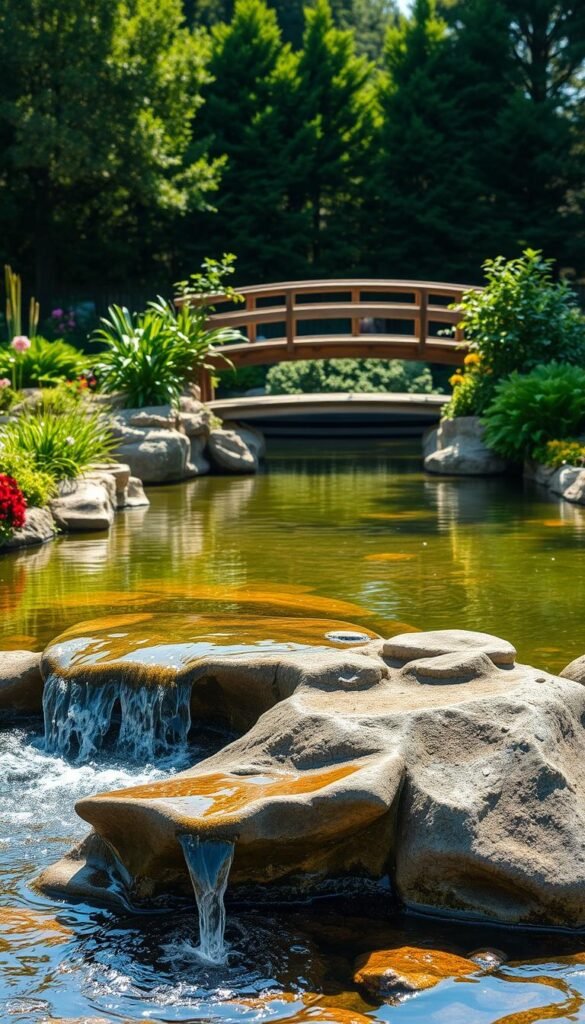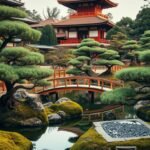Imagine stepping into your backyard and hearing gentle trickles that melt away stress while wildlife dances around shimmering surfaces. Liquid elements transform ordinary yards into living art, blending sight and sound for multisensory escapes. Whether you’re drawn to bubbling fountains or cascading streams, these installations do more than beautify – they create natural hubs for relaxation and connection.
Modern options range from compact wall-mounted displays to sprawling aquatic ecosystems. Solar-powered units eliminate wiring hassles, while materials like aged copper or polished concrete match various styles. Positioning matters too – placing features near seating areas amplifies their calming effects, as our guide to elevating your space explains.
Smart planning ensures your investment becomes a cherished part of daily life. Consider maintenance needs alongside visual appeal – pondless waterfalls offer drama without extensive upkeep, while tiered fountains make elegant statements in formal settings. Each choice impacts property value and personal enjoyment differently.
This exploration will help you navigate options that fit your lifestyle and terrain. You’ll discover how flowing elements attract butterflies, mask neighborhood noise, and turn ordinary corners into conversation starters. Let’s dive into creating liquid landscapes that refresh both eyes and spirit.
Understanding the Benefits of Garden Pond Design
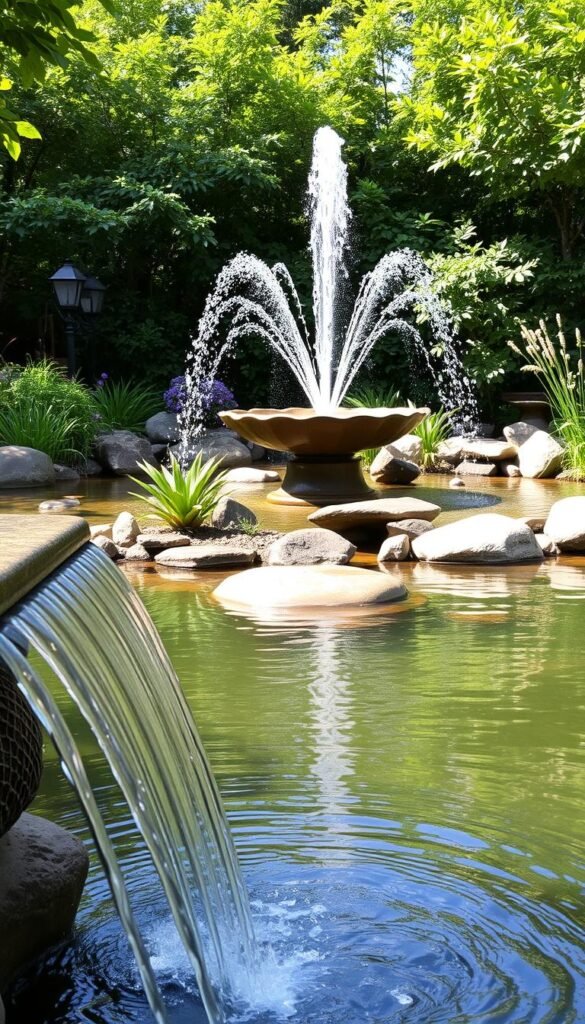
Outdoor spaces come alive when liquid elements become their heartbeat. These installations do more than decorate – they reimagine how you experience nature daily. Let’s explore why these flowing additions deserve a starring role in your personal oasis.
Elevating Visual Charm
Moving water becomes an instant focal point, commanding attention with shimmering reflections. A well-placed fountain or cascading stream adds depth to flat terrain, while stone basins introduce texture. “The right water element acts like jewelry for your yard,” notes landscape architect Mara Linwood. “It pulls everything together.”
These dynamic installations create ever-changing displays. Morning light dances across ripples, while evening spotlights turn sprays into liquid crystal. You’ll notice neighbors lingering longer during gatherings, drawn to the hypnotic motion.
Nature’s Welcome Mat
Birds splash in shallow edges as dragonflies skim surfaces. The gentle sound of trickling water masks street noise, wrapping your space in peaceful tranquility. Pollinators flock to moisture sources, boosting plant health through increased pollination.
Practical perks shine too. Evaporation cools surrounding areas naturally – perfect for summer lounging. Over time, these ecosystems become self-sustaining habitats. You’re not just decorating your yard; you’re building a legacy that future homeowners will cherish.
Planning Your Garden Pond and Water Feature Layout
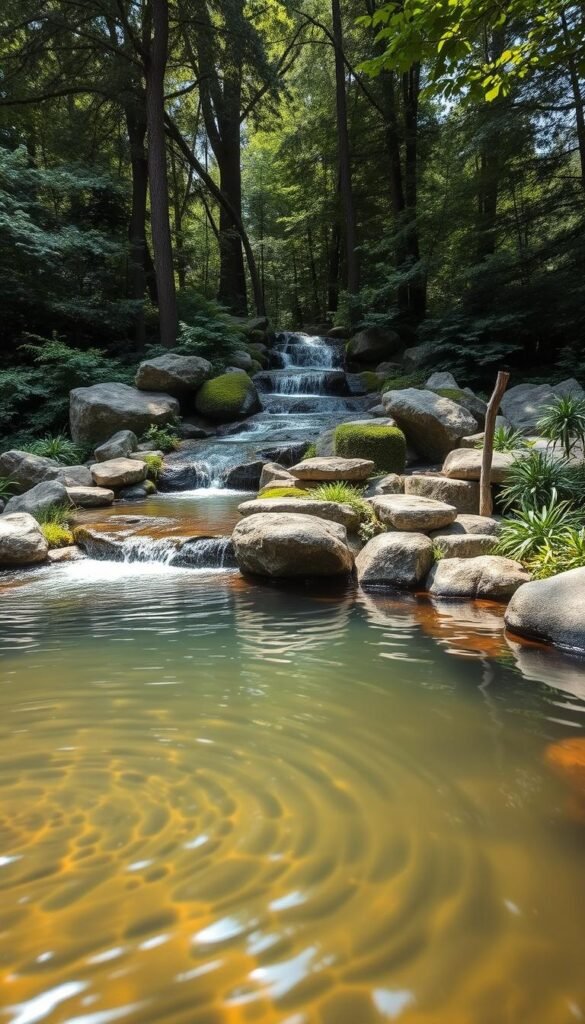
Turning liquid dreams into reality starts with smart preparation. Thoughtful arrangement prevents overcrowding while maximizing visual impact and functionality. Let’s map out strategies that balance creativity with practicality.
Smart Space & Budget Foundations
Start by measuring your outdoor space with a tape measure or digital app. Sloped terrain works for cascading streams, while flat areas suit reflecting pools. Jot down existing elements like trees or patios that could influence placement.
Create a budget spreadsheet with columns for materials, labor, and hidden costs like permits. Recirculating pumps cost $50-$800, while natural stone edging runs $20-$50 per square foot. “Always add 15% cushion for unexpected expenses,” advises contractor Luis Martinez.
Style Syncing Made Simple
Modern homes shine with geometric water features like angular concrete fountains. Rustic settings pair with mossy rock waterfalls or reclaimed troughs. Match materials to your home’s exterior – copper basins complement Craftsman bungalows, while slate fits mid-century designs.
Consider maintenance when choosing options. Self-cleaning filters work for busy families, while koi ponds need weekly care. Check local codes about depth restrictions or fence requirements near water feature installations.
- Sketch multiple layout ideas using grid paper
- Compare pump energy efficiency ratings
- Schedule utility line checks before digging
Garden Pond Design: Adding Water Features to Enhance Your Landscape
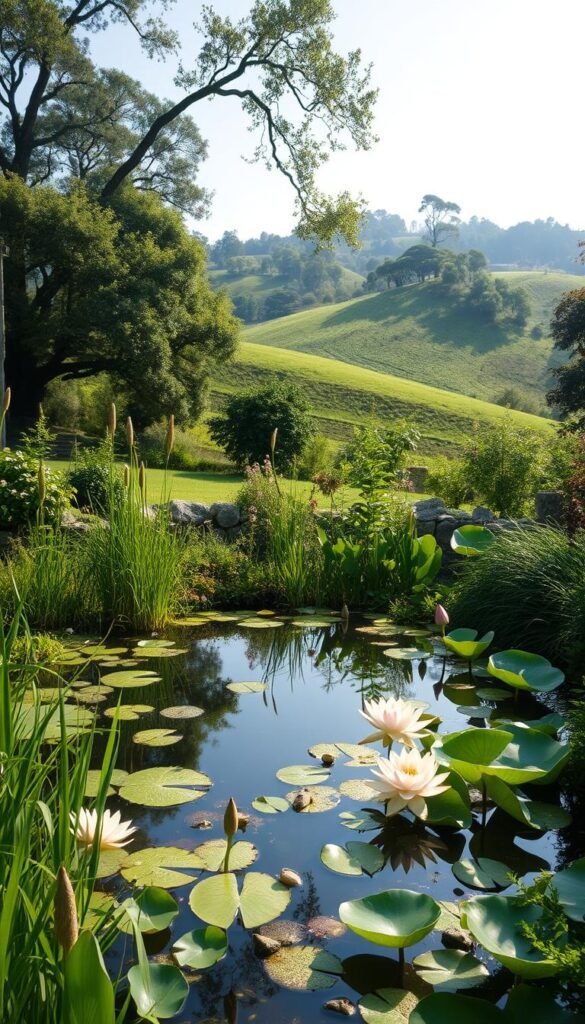
Your space deserves flowing elements that reflect both personality and practicality. Let’s explore how to pair features with your lifestyle while creating cohesive compositions.
Selecting the Right Features for Your Needs
Start by asking: “What role should water play here?” Compact bubbling pots suit cozy patios, while tiered fountains anchor expansive lawns. For low-maintenance charm, pondless waterfalls recycle water without algae concerns.
| Feature Type | Best For | Care Level |
|---|---|---|
| Koi ponds | Natural ecosystems | Weekly upkeep |
| Water walls | Modern aesthetics | Seasonal cleaning |
| Garden streams | Sloped yards | Debris removal |
Integrating Ponds, Fountains, and Waterfalls
Connect elements like puzzle pieces. A waterfall feeding into a koi pond creates movement and filtration. Pair wall fountains with aquatic plants for vertical-horizontal balance. Remember: recirculating systems save water and energy.
Consider sustainable practices from permaculture design when planning layouts. For inspiration on multi-element installations, explore professional integration techniques that blend form and function seamlessly.
Design Ideas and DIY Tips for a Stunning Outdoor Oasis
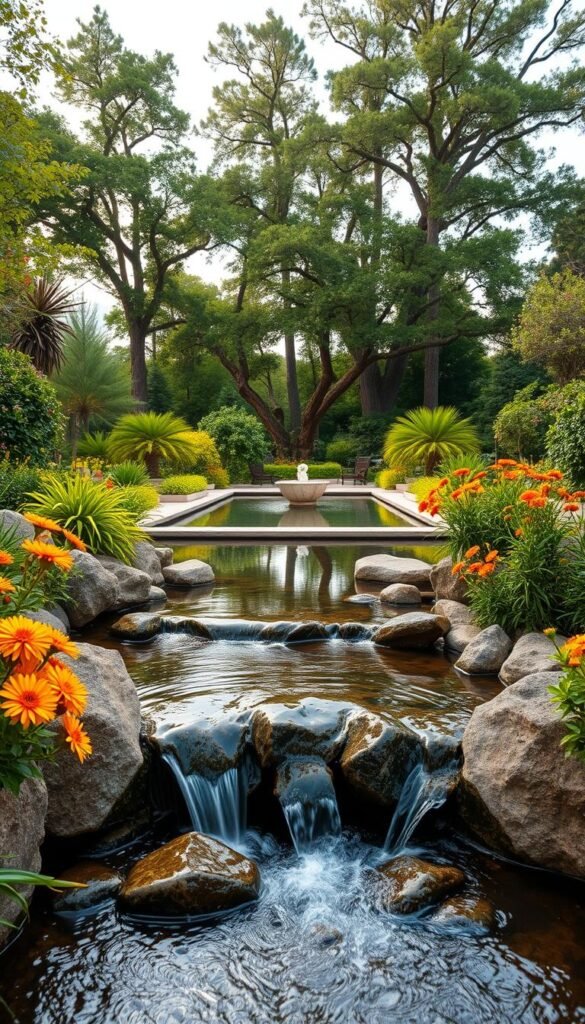
Transform your yard into a captivating retreat with flowing elements that balance creativity and practicality. Whether you’re crafting a zen-inspired corner or a lively entertainment hub, these strategies turn ordinary spaces into liquid masterpieces.
Creating Focal Points with Flowing Water
Pondless installations steal the show while saving time. Water cascades over stacked stones into hidden reservoirs, creating mesmerizing movement without algae worries. “These systems let busy homeowners enjoy nature’s music without weekend cleanups,” says aquatic designer Carla Simmons.
For budget-friendly charm, try recirculating fountains. Core-drilled boulders spill water into pebble-filled basins, while ceramic urns bubble rhythmically. Pre-made kits simplify installation – most require only a shovel, level, and afternoon.
| Project Type | DIY Difficulty | Cost Range |
|---|---|---|
| Bubbling rocks | Beginner | $150-$400 |
| Tiered fountains | Intermediate | $600-$1,200 |
| Multi-tier waterfalls | Expert/Professional | $2,500+ |
Blend water elements with existing creative gardening ideas for cohesive beauty. Surround stone fountains with drought-resistant succulents, or flank streams with ornamental grasses. Solar lights add evening drama when reflected in moving surfaces.
Remember: complex projects need expert help. Steep slopes require proper drainage, while fish ponds demand precise pH balancing. Start small – even a $50 tabletop fountain brings liquid magic to patios.
Bringing Your Water-Inspired Vision to Life
Collaborating with experts ensures your aquatic dreams flow seamlessly into reality. Trusted professionals use 3D modeling technology to show your future space in vivid detail before digging begins. This smart approach helps refine layouts and prevents costly mid-project changes.
Seasoned contractors bring hidden value through decades of hands-on experience. They balance aesthetics with practical needs like drainage and pump placement. Ask about warranties – quality installers often back their work with multi-year guarantees.
Regular care keeps your liquid elements sparkling. Schedule monthly skimming for debris and annual pump checkups. Simple habits like trimming nearby plants prevent leaf buildup while preserving that soothing tranquility you love.
Your transformed space becomes more than decoration – it’s an investment in daily joy. With proper planning and expert execution, those calming ripples will greet you season after season. Ready to take the plunge? Your personal oasis awaits.

